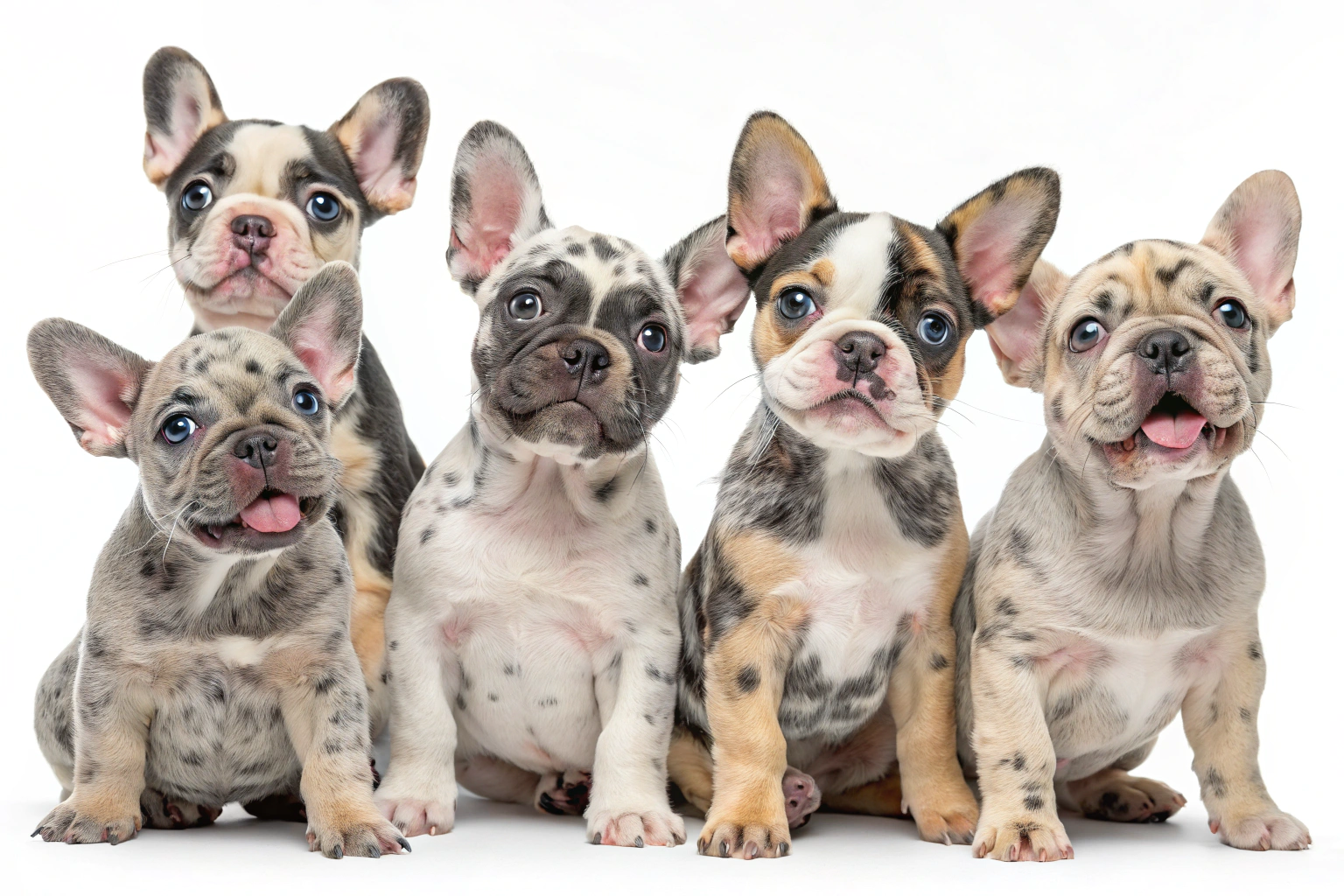7 Best Merle French Bulldog Features You’ll Adore!
Are you captivated by those striking coat patterns that seem to be splashed with artistic flair? The merle French Bulldog has been stealing hearts with its unique appearance and lovable personality. These rare beauties combine the classic Frenchie charm with a stunning coat variation that makes them truly stand out in the canine world. Whether you’re considering adding one to your family or simply fascinated by these special pups, understanding what makes merle French Bulldogs so extraordinary is essential for any dog enthusiast.
Introduction
The merle French Bulldog represents one of the most visually striking variations of the beloved French Bulldog breed. With their distinctive mottled coat patterns and often captivating eyes, these dogs have skyrocketed in popularity despite some controversy surrounding their breeding. Their unique aesthetic combined with the classic Frenchie temperament creates an irresistible package for many dog lovers.
Understanding these special dogs goes beyond appreciating their beautiful appearance. The merle gene creates not just visual differences but can impact health considerations and care requirements that potential owners should be well-informed about.
Did you know that no two merle French Bulldogs have identical coat patterns? Each pup sports a completely unique marbling effect, making every merle Frenchie a one-of-a-kind canine companion!
Species Overview
Scientific Name: Canis lupus familiaris (domestic dog)
Physical Characteristics: Merle French Bulldogs maintain the compact, muscular build characteristic of the breed, typically weighing between 16-28 pounds and standing about 11-13 inches tall. Their most distinctive feature is, of course, the merle coat pattern—a dilution gene that creates patches of lighter color within the base coat, creating a mottled or dappled effect.
The merle pattern can appear in various color combinations:
- Blue merle (gray patches on black)
- Chocolate merle (lighter brown patches on dark brown)
- Lilac merle (pale patches on a diluted chocolate base)
- Fawn merle (lighter patches on a fawn base)
Beyond their coats, merle French Bulldogs often have striking blue or heterochromatic (different-colored) eyes, pink-spotted noses, and paw pads that complement their unique appearance.
Breed Variations: While the merle pattern is the focal point, these dogs can display various combinations of merle with other coat patterns and colors, including:
- Merle with brindle
- Merle with pied markings
- Merle with tan points
It’s worth noting that the merle pattern is not naturally occurring in the French Bulldog’s genetic makeup; it was introduced through crossbreeding, which has led to some controversy within breeding circles and varying recognition by kennel clubs.
Habitat and Distribution
Natural Habitat: As companion dogs, merle French Bulldogs thrive in home environments. Their brachycephalic (flat-faced) structure makes them particularly suited to temperature-controlled indoor living. These dogs adapt well to apartment living due to their moderate activity needs and compact size.
Geographic Range: While the French Bulldog originated in England before being refined in France, the merle variation has gained particular popularity in the United States, Australia, and parts of Europe. Their distribution is primarily determined by breeder concentration and local regulations regarding merle breeding practices.
Adaptations: Merle French Bulldogs have retained the adaptations of standard French Bulldogs, including:
- A compact body designed for companionship rather than working
- Limited exercise requirements suitable for urban living
- Heat intolerance due to facial structure (requiring climate-controlled environments)
- Strong bonding capacity with human families
However, the merle gene itself isn’t an adaptation but a genetic modification that affects coat color and occasionally other physical traits. This genetic difference requires special consideration during breeding to prevent health complications.
Diet and Feeding Habits
What They Eat: Merle French Bulldogs require high-quality nutrition like all French Bulldogs. Their diet should consist of premium dog food formulated for small to medium brachycephalic breeds, with proper proportions of:
- Protein (23-28%) for muscle maintenance
- Healthy fats (12-16%) for coat health and energy
- Limited carbohydrates to prevent weight gain
- Appropriate vitamin and mineral content
Feeding Behavior: These dogs tend to eat enthusiastically but can be prone to digestive issues. Their flat face structure can also make eating challenging, so raised food bowls are often recommended to reduce strain and improve digestion.
Dietary Needs: Merle French Bulldogs may have specific nutritional considerations:
- Weight management is crucial as obesity can exacerbate breathing difficulties
- Some may benefit from foods formulated for sensitive digestion
- Supplements like omega fatty acids can support skin and coat health—particularly important for maintaining the vibrant merle pattern
Some owners opt for specially formulated diets addressing breed-specific concerns, while others choose raw or home-prepared diets under veterinary guidance.
Behavior and Social Structure
Social Behavior: Merle French Bulldogs inherit the classic Frenchie personality—affectionate, playful, and social. They typically display:
- Strong attachment to their human families
- Good relationships with children when properly socialized
- Moderate friendliness toward strangers
- Variable compatibility with other pets (often good with proper introduction)
These dogs thrive on human interaction and can suffer from separation anxiety if left alone for extended periods.
Communication: Despite not being overly vocal, merle French Bulldogs communicate effectively through:
- Distinctive Frenchie “talking”—a combination of grunts, snorts, and yodels
- Expressive facial expressions enhanced by their unique eye colors
- Body language including the famous Frenchie “hop” when excited
- Attentive eye contact with owners
Mating and Reproduction: Breeding merle French Bulldogs requires special knowledge and ethical considerations:
- Breeding two merles together (merle-to-merle breeding) is strongly discouraged as it can produce “double merle” puppies with serious health issues
- Most ethical breeders pair a merle with a solid-colored French Bulldog
- Many merle Frenchies require artificial insemination and cesarean sections due to their body structure
- Litters typically consist of 2-4 puppies
- Responsible breeding includes genetic testing for health issues
The lifespan of properly bred merle French Bulldogs generally ranges from 10-12 years, similar to standard French Bulldogs.
Conservation Status
Breed Recognition: The merle pattern in French Bulldogs has varying levels of acceptance:
- Not recognized by the American Kennel Club (AKC) as a standard color
- Accepted by some international kennel clubs with restrictions
- Subject to ongoing debate within breeding communities
Ethical Concerns: The primary “threats” to merle French Bulldogs involve breeding practices:
- Unethical breeding for profit without health testing
- Merle-to-merle breeding resulting in puppies with health defects
- Overbreeding leading to genetic diversity issues
Responsible Practices: Efforts to ensure the ethical breeding of merle French Bulldogs include:
- Educational programs for breeders and prospective owners
- Genetic testing requirements by reputable breeding associations
- Transparency about the merle gene’s introduction to the breed
- Advocacy for responsible breeding practices that prioritize health over appearance
7 Incredible Features of the Merle French Bulldog

1. Mesmerizing Coat Patterns
The most obvious and captivating feature of merle French Bulldogs is their stunning coat pattern. The random patches of diluted color create a marbled effect that makes each dog truly one-of-a-kind. The merle gene affects the distribution of pigment in the coat, creating a beautiful mottled appearance that can range from subtle to dramatic.
The pattern’s uniqueness means your merle Frenchie will be instantly recognizable and stand out from the crowd. Many owners report that their merle’s coat seems to shift and change appearance depending on lighting, almost like a living canvas.
2. Captivating Eye Colors
Perhaps equally striking as their coats are the eye colors possible in merle French Bulldogs. While standard Frenchies typically have dark brown eyes, merles often display:
- Bright blue eyes
- Heterochromia (different colored eyes)
- Segmented or “cracked” eyes with multiple colors
- Green or amber hues
These unique eye colorations result from the same pigment-affecting gene that creates the merle coat pattern. The combination of distinctive coat patterns with unusual eye colors creates an almost mystical appearance that many find irresistible.
3. Classic Frenchie Personality in a Unique Package
Merle French Bulldogs retain all the lovable personality traits that have made Frenchies one of America’s most popular breeds:
- Playful yet not hyperactive
- Affectionate and cuddly
- Comical with a natural talent for entertaining their families
- Intelligent with a streak of stubbornness
- Adaptable to various living situations
This winning personality in combination with their head-turning appearance makes merle French Bulldogs particularly special. They offer the temperament that Frenchie lovers adore with an aesthetic appeal that’s truly distinctive.
4. Compact Size with Major Presence
Like all French Bulldogs, merles maintain a perfectly apartment-friendly size without sacrificing presence:
- Small enough for comfortable urban living (16-28 pounds)
- Substantial enough to feel like a “real dog”
- Low exercise requirements that suit busy lifestyles
- Sturdy build despite their compact frame
Their moderate size makes them adaptable to various living situations while their unique appearance ensures they’ll never be overlooked—a perfect combination for those wanting a distinctive companion that fits into their lifestyle.
5. Diverse Merle Variations
The merle pattern appears in an exciting array of combinations, giving potential owners many options to fall in love with:
- Blue merle (the most common and recognizable)
- Chocolate merle (rich brown tones)
- Lilac merle (a diluted, softer tone)
- Fawn merle (warm beige base with lighter patches)
These variations can further combine with other patterns like brindle or pied markings, creating even more distinctive looks. This diversity means there’s likely a merle Frenchie with exactly the color combination that appeals to your aesthetic preferences.
6. Conversation-Starting Appeal
Few dog breeds generate as much curiosity and conversation as merle French Bulldogs. Their unusual appearance inevitably leads to questions and compliments, making them:
- Natural icebreakers in social situations
- Popular on social media platforms
- Recognizable even to non-dog enthusiasts
- Memorable to everyone they meet
For the socially-minded pet owner, a merle Frenchie provides countless opportunities for connection through the shared appreciation of these uniquely beautiful dogs.
7. Strong Bonding Capacity
Merle French Bulldogs typically form exceptionally strong bonds with their families. Their desire to be involved in all aspects of family life manifests in:
- Velcro-like attachment to their favorite people
- Intuitive understanding of human emotions
- Adaptability to family routines and schedules
- Genuine enjoyment of human company above all else
This profound connection makes them ideal companions for those seeking a deeply bonded relationship with their pet. Many merle Frenchie owners report that their dogs seem to understand them on an almost uncanny level.
Tips for Caring for Merle French Bulldogs
Caring for a merle French Bulldog requires some specialized knowledge to ensure they remain healthy and happy:
Health Monitoring:
- Regular veterinary check-ups (every 6 months is ideal)
- Special attention to eye health, as merles can be more susceptible to certain eye conditions
- Hearing tests, as some merles may have hearing impairments
- Skin checks, as their unique pigmentation can sometimes be associated with sensitivity
Grooming Needs:
- Weekly brushing to maintain coat condition and reduce shedding
- Regular cleaning of facial wrinkles to prevent infection
- Nail trimming every 3-4 weeks
- Ear cleaning to prevent infections
- Limited bathing (monthly is typically sufficient) with dog-specific shampoos
Temperature Control:
- Air conditioning during hot weather is essential
- Limited outdoor time during extreme temperatures
- Cooling vests or mats during summer months
- Appropriate winter protection despite their seemingly sturdy appearance
Exercise Balance:
- 20-30 minutes of daily activity spread throughout the day
- Mental stimulation through puzzle toys
- Avoidance of strenuous exercise that can trigger breathing difficulties
- Low-impact activities like short walks and gentle play sessions
Training Considerations:
- Positive reinforcement methods work best
- Short, consistent training sessions accommodate their attention span
- Early socialization is crucial for developing good manners
- Patience with their occasionally stubborn nature
Role in the Ecosystem
Domestic Role:
While not serving a natural ecosystem function like wild animals, merle French Bulldogs fulfill important roles in human households:
- Companionship that has been shown to reduce stress and improve mental health
- Therapy and emotional support capabilities
- Social facilitation in communities through dog parks and pet-friendly events
Breeding Considerations:
The responsible breeding of merle French Bulldogs has wider implications:
- Ethical breeders contribute to maintaining genetic diversity
- Educational opportunities about genetics and inheritance
- Discussions about breed standards and health versus appearance priorities
Cultural Impact:
Merle French Bulldogs have influenced various aspects of culture:
- Social media presence and influence on pet trends
- Discussions about designer dogs and breeding ethics
- Representation in advertising and media
Conclusion
The merle French Bulldog represents a fascinating combination of the beloved Frenchie personality with truly unique aesthetics. Their distinctive coat patterns, captivating eyes, and classic French Bulldog charm make them increasingly sought after companions. However, potential owners should approach with knowledge and responsibility, understanding both the joys and challenges these special dogs bring.
If you’re considering adding a merle French Bulldog to your family, ensure you work with reputable breeders who prioritize health testing and ethical breeding practices. The higher price tag for these rare dogs should reflect careful breeding rather than simply rare coloration.
For those who appreciate both inner and outer beauty in the canine world, a merle French Bulldog offers an extraordinary package—a loyal, affectionate companion with an appearance as unique as their personality. With proper care, understanding, and responsible ownership, these distinctive dogs can bring years of joy, companionship, and undeniable visual splendor to the right homes.
Frequently Asked Questions
Are merle French Bulldogs recognized by major kennel clubs?
No, the merle coat pattern is not recognized in French Bulldogs by the American Kennel Club (AKC) or many other major kennel clubs. This is because the merle gene doesn’t occur naturally in French Bulldogs and was likely introduced through crossbreeding. Some smaller registries may recognize them, but they cannot be shown in major conformation events.
Why are merle French Bulldogs so expensive?
Merle French Bulldogs typically cost between $5,000-$15,000, considerably more than standard Frenchies. This premium price reflects their rarity, the higher costs associated with responsible breeding practices (including genetic testing), and simply the high demand for their unique appearance. Unfortunately, the high price tag also attracts unethical breeders, making it essential to research breeders thoroughly.
What health issues should I watch for in a merle French Bulldog?
Besides the standard French Bulldog health concerns (breathing issues, spinal problems, etc.), merle Frenchies may be prone to:
- Vision problems, including increased risk of eye abnormalities
- Hearing impairments (particularly in predominantly white merles)
- Skin sensitivities and allergies
- Higher risk of congenital defects if from a merle-to-merle breeding
Regular veterinary check-ups are crucial for monitoring and addressing these potential issues.
Is it true that breeding two merle dogs together is dangerous?
Yes, breeding two merle-patterned dogs together (merle-to-merle breeding) significantly increases the risk of producing “double merle” puppies. Double merles have a high likelihood of serious health issues including blindness, deafness, and other developmental problems. Responsible breeders will only breed a merle to a solid-colored dog to avoid these risks.
How can I ensure I’m buying from an ethical merle French Bulldog breeder?
Look for breeders who:
- Perform health testing on breeding pairs (including DNA tests for the merle gene)
- Never breed merle-to-merle
- Are transparent about their breeding practices
- Provide detailed health records and genetic testing results
- Allow you to meet the puppy’s parents or at least the mother
- Offer health guarantees and ongoing support
- Prioritize health and temperament over rare colors or patterns
Do merle French Bulldogs require special care compared to standard Frenchies?
The core care requirements remain similar to standard French Bulldogs, but merles might need:
- More diligent sun protection due to lighter pigmentation
- Regular hearing and vision checks
- Special attention to skin care, as some merles have more sensitive skin
- Awareness of potential temperature sensitivity due to their coloration
Are merle French Bulldogs good family pets?
Yes, merle French Bulldogs typically make excellent family companions. They inherit the standard Frenchie’s loving, playful personality and generally do well with children. Their moderate size and energy level make them adaptable to many family situations, though their potential health concerns should be considered when choosing a family pet.







